tow BUICK LUCERNE 2007 Owner's Guide
[x] Cancel search | Manufacturer: BUICK, Model Year: 2007, Model line: LUCERNE, Model: BUICK LUCERNE 2007Pages: 496, PDF Size: 2.77 MB
Page 319 of 496
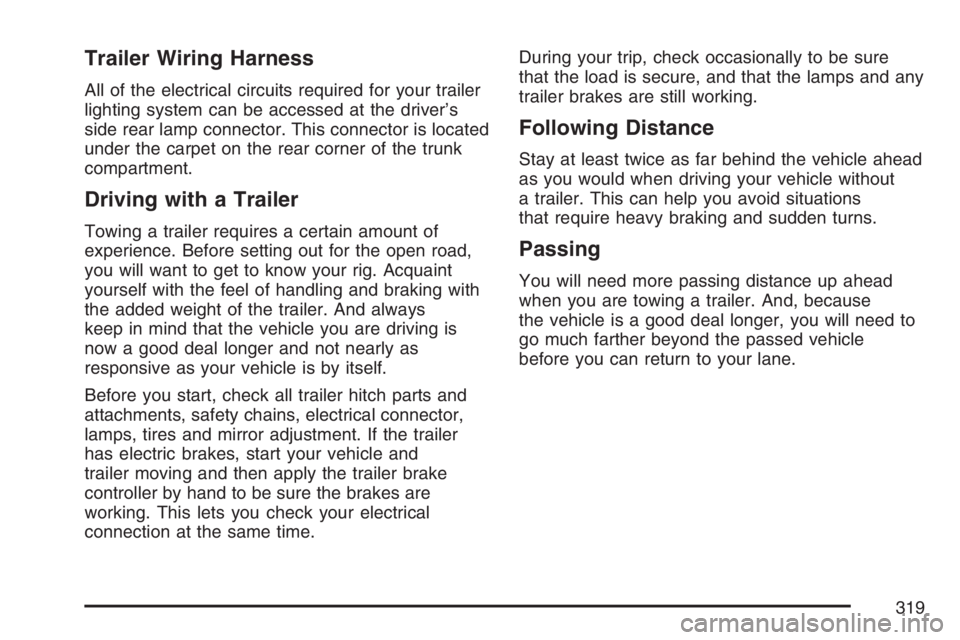
Trailer Wiring Harness
All of the electrical circuits required for your trailer
lighting system can be accessed at the driver’s
side rear lamp connector. This connector is located
under the carpet on the rear corner of the trunk
compartment.
Driving with a Trailer
Towing a trailer requires a certain amount of
experience. Before setting out for the open road,
you will want to get to know your rig. Acquaint
yourself with the feel of handling and braking with
the added weight of the trailer. And always
keep in mind that the vehicle you are driving is
now a good deal longer and not nearly as
responsive as your vehicle is by itself.
Before you start, check all trailer hitch parts and
attachments, safety chains, electrical connector,
lamps, tires and mirror adjustment. If the trailer
has electric brakes, start your vehicle and
trailer moving and then apply the trailer brake
controller by hand to be sure the brakes are
working. This lets you check your electrical
connection at the same time.During your trip, check occasionally to be sure
that the load is secure, and that the lamps and any
trailer brakes are still working.
Following Distance
Stay at least twice as far behind the vehicle ahead
as you would when driving your vehicle without
a trailer. This can help you avoid situations
that require heavy braking and sudden turns.
Passing
You will need more passing distance up ahead
when you are towing a trailer. And, because
the vehicle is a good deal longer, you will need to
go much farther beyond the passed vehicle
before you can return to your lane.
319
Page 320 of 496
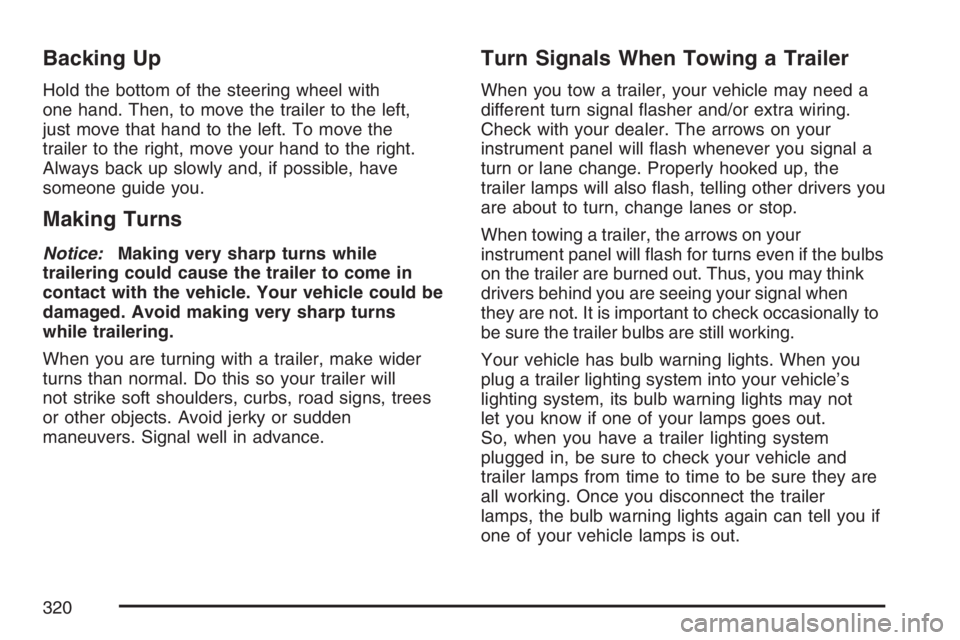
Backing Up
Hold the bottom of the steering wheel with
one hand. Then, to move the trailer to the left,
just move that hand to the left. To move the
trailer to the right, move your hand to the right.
Always back up slowly and, if possible, have
someone guide you.
Making Turns
Notice:Making very sharp turns while
trailering could cause the trailer to come in
contact with the vehicle. Your vehicle could be
damaged. Avoid making very sharp turns
while trailering.
When you are turning with a trailer, make wider
turns than normal. Do this so your trailer will
not strike soft shoulders, curbs, road signs, trees
or other objects. Avoid jerky or sudden
maneuvers. Signal well in advance.
Turn Signals When Towing a Trailer
When you tow a trailer, your vehicle may need a
different turn signal �asher and/or extra wiring.
Check with your dealer. The arrows on your
instrument panel will �ash whenever you signal a
turn or lane change. Properly hooked up, the
trailer lamps will also �ash, telling other drivers you
are about to turn, change lanes or stop.
When towing a trailer, the arrows on your
instrument panel will �ash for turns even if the bulbs
on the trailer are burned out. Thus, you may think
drivers behind you are seeing your signal when
they are not. It is important to check occasionally to
be sure the trailer bulbs are still working.
Your vehicle has bulb warning lights. When you
plug a trailer lighting system into your vehicle’s
lighting system, its bulb warning lights may not
let you know if one of your lamps goes out.
So, when you have a trailer lighting system
plugged in, be sure to check your vehicle and
trailer lamps from time to time to be sure they are
all working. Once you disconnect the trailer
lamps, the bulb warning lights again can tell you if
one of your vehicle lamps is out.
320
Page 322 of 496
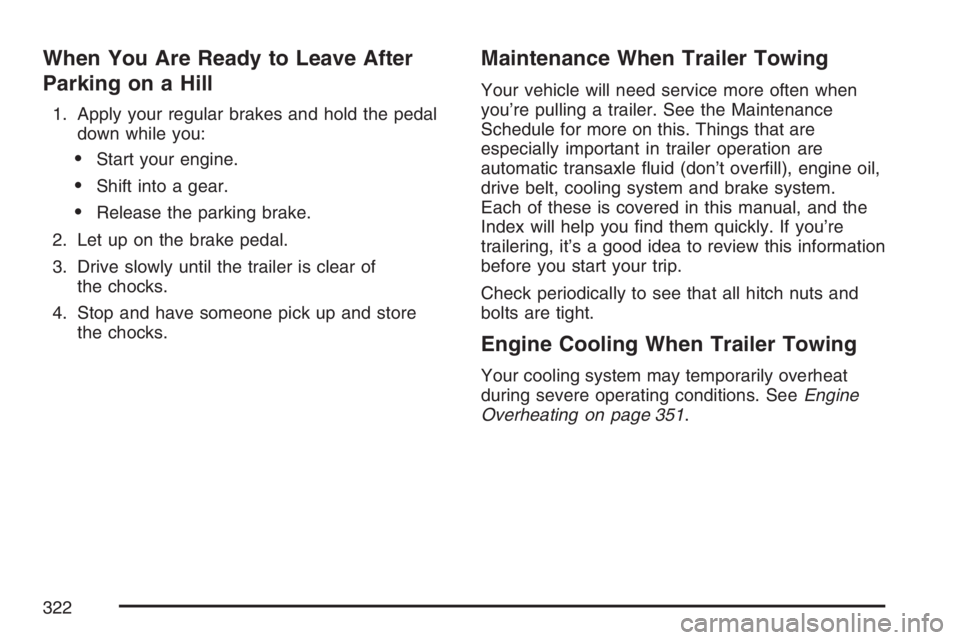
When You Are Ready to Leave After
Parking on a Hill
1. Apply your regular brakes and hold the pedal
down while you:
Start your engine.
Shift into a gear.
Release the parking brake.
2. Let up on the brake pedal.
3. Drive slowly until the trailer is clear of
the chocks.
4. Stop and have someone pick up and store
the chocks.
Maintenance When Trailer Towing
Your vehicle will need service more often when
you’re pulling a trailer. See the Maintenance
Schedule for more on this. Things that are
especially important in trailer operation are
automatic transaxle �uid (don’t over�ll), engine oil,
drive belt, cooling system and brake system.
Each of these is covered in this manual, and the
Index will help you �nd them quickly. If you’re
trailering, it’s a good idea to review this information
before you start your trip.
Check periodically to see that all hitch nuts and
bolts are tight.
Engine Cooling When Trailer Towing
Your cooling system may temporarily overheat
during severe operating conditions. SeeEngine
Overheating on page 351.
322
Page 337 of 496

A. Underhood Fuse Block. SeeUnderhood Fuse
Block on page 428.
B. Remote Positive (+) Battery Terminal. See
Jump Starting on page 372.
C. Windshield Washer Fluid Reservoir. See
“Adding Washer Fluid” underWindshield
Washer Fluid on page 365.
D. Engine Coolant Surge Tank. See Index.
E. Power Steering Fluid. SeePower Steering
Fluid on page 364.
F. Engine Oil Fill Cap. See “When to Add Engine
Oil” underEngine Oil on page 337.
G. Engine Oil Dipstick. See “Checking Engine Oil”
underEngine Oil on page 337.
H. Brake Master Cylinder. See “Brake Fluid” under
Brakes on page 367.
I. Automatic Transaxle Fluid Cap and Dipstick
(Out of View). SeeAutomatic Transaxle
Fluid on page 343.
J. Engine Air Cleaner/Filter. SeeEngine Air
Cleaner/Filter on page 342.Engine Oil
If the OIL LEVEL LOW ADD OIL message
appears in the Driver Information Center (DIC), it
means you need to check the engine oil level
right away. For more information, seeDIC
Warnings and Messages on page 221. You should
check the engine oil level regularly; this is an
added reminder.
Checking Engine Oil
It is a good idea to check the engine oil every time
you get fuel. In order to get an accurate reading,
the oil must be warm and the vehicle must be
on level ground.
The engine oil dipstick handle is a yellow loop.
SeeEngine Compartment Overview on page 334
for the location of the engine oil dipstick.
1. Turn off the engine and give the oil several
minutes to drain back into the oil pan. If you
do not do this, the oil dipstick might not
show the actual level.
2. Pull out the dipstick and clean it with a paper
towel or cloth, then push it back in all the
way. Remove it again, keeping the tip down,
and check the level.
337
Page 342 of 496
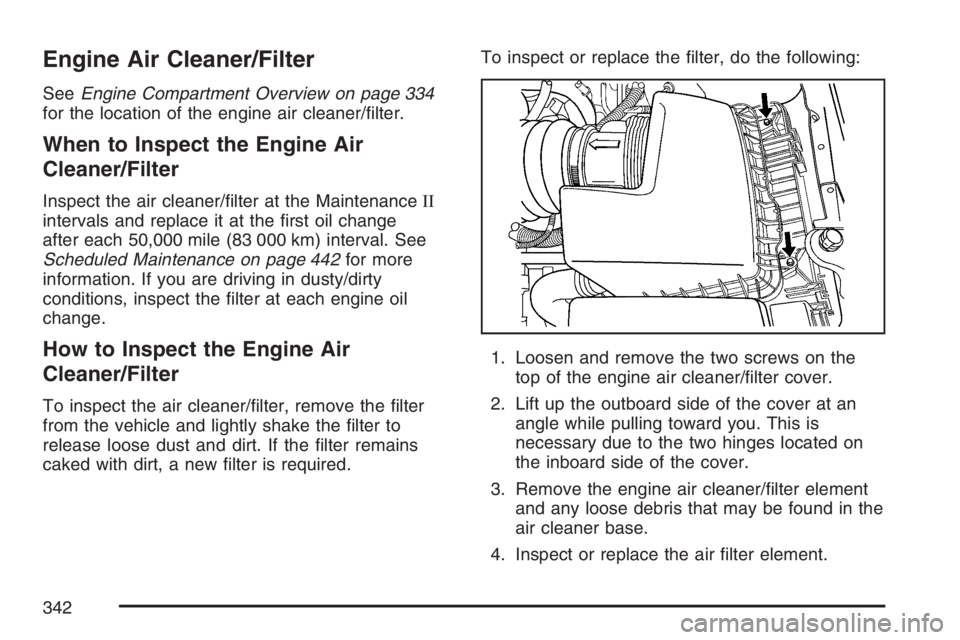
Engine Air Cleaner/Filter
SeeEngine Compartment Overview on page 334
for the location of the engine air cleaner/�lter.
When to Inspect the Engine Air
Cleaner/Filter
Inspect the air cleaner/�lter at the MaintenanceII
intervals and replace it at the �rst oil change
after each 50,000 mile (83 000 km) interval. See
Scheduled Maintenance on page 442for more
information. If you are driving in dusty/dirty
conditions, inspect the �lter at each engine oil
change.
How to Inspect the Engine Air
Cleaner/Filter
To inspect the air cleaner/�lter, remove the �lter
from the vehicle and lightly shake the �lter to
release loose dust and dirt. If the �lter remains
caked with dirt, a new �lter is required.To inspect or replace the �lter, do the following:
1. Loosen and remove the two screws on the
top of the engine air cleaner/�lter cover.
2. Lift up the outboard side of the cover at an
angle while pulling toward you. This is
necessary due to the two hinges located on
the inboard side of the cover.
3. Remove the engine air cleaner/�lter element
and any loose debris that may be found in the
air cleaner base.
4. Inspect or replace the air �lter element.
342
Page 343 of 496
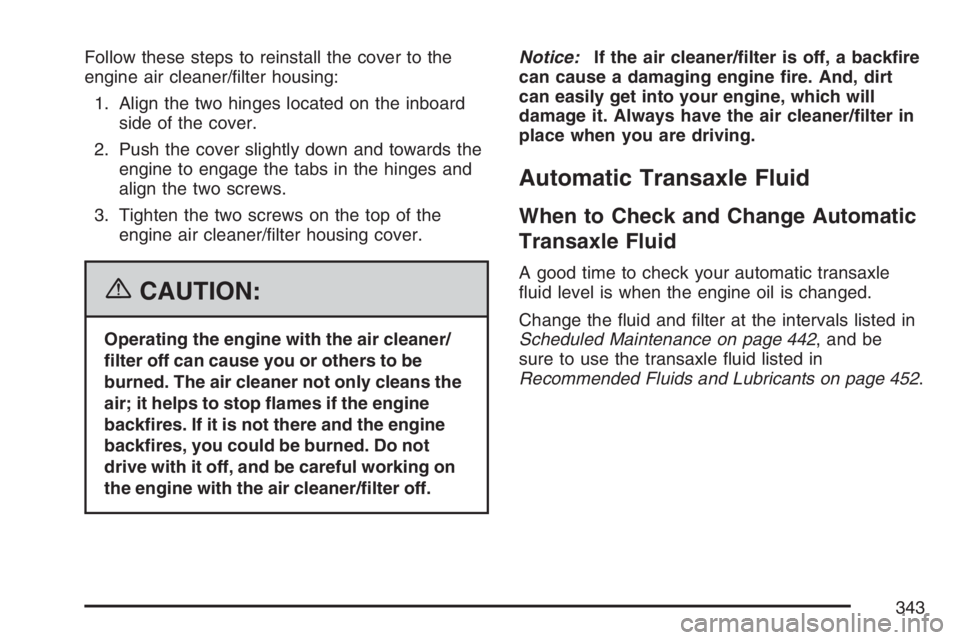
Follow these steps to reinstall the cover to the
engine air cleaner/�lter housing:
1. Align the two hinges located on the inboard
side of the cover.
2. Push the cover slightly down and towards the
engine to engage the tabs in the hinges and
align the two screws.
3. Tighten the two screws on the top of the
engine air cleaner/�lter housing cover.
{CAUTION:
Operating the engine with the air cleaner/
�lter off can cause you or others to be
burned. The air cleaner not only cleans the
air; it helps to stop �ames if the engine
back�res. If it is not there and the engine
back�res, you could be burned. Do not
drive with it off, and be careful working on
the engine with the air cleaner/�lter off.Notice:If the air cleaner/�lter is off, a back�re
can cause a damaging engine �re. And, dirt
can easily get into your engine, which will
damage it. Always have the air cleaner/�lter in
place when you are driving.
Automatic Transaxle Fluid
When to Check and Change Automatic
Transaxle Fluid
A good time to check your automatic transaxle
�uid level is when the engine oil is changed.
Change the �uid and �lter at the intervals listed in
Scheduled Maintenance on page 442, and be
sure to use the transaxle �uid listed in
Recommended Fluids and Lubricants on page 452.
343
Page 345 of 496
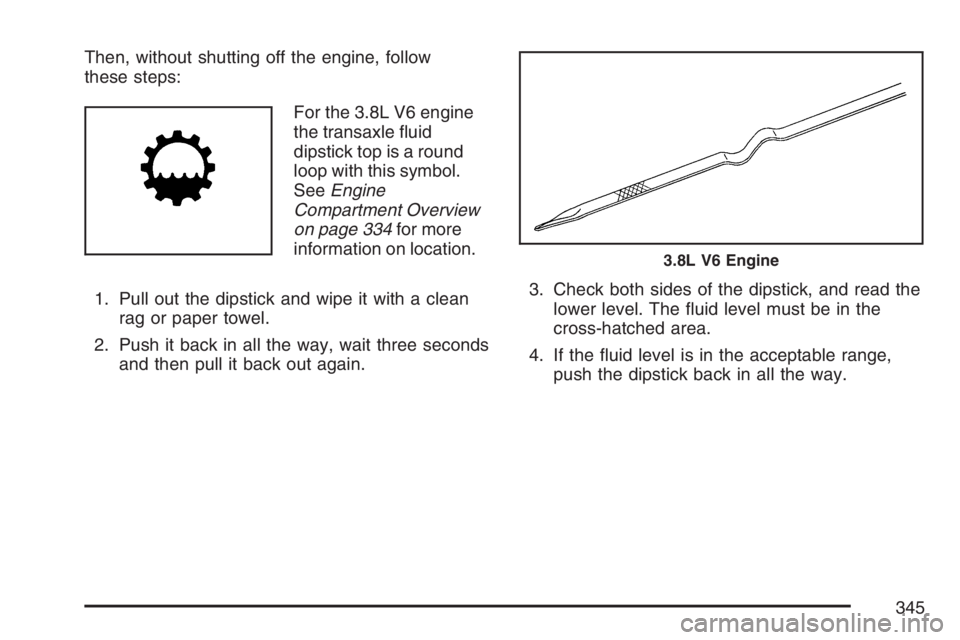
Then, without shutting off the engine, follow
these steps:
For the 3.8L V6 engine
the transaxle �uid
dipstick top is a round
loop with this symbol.
SeeEngine
Compartment Overview
on page 334for more
information on location.
1. Pull out the dipstick and wipe it with a clean
rag or paper towel.
2. Push it back in all the way, wait three seconds
and then pull it back out again.3. Check both sides of the dipstick, and read the
lower level. The �uid level must be in the
cross-hatched area.
4. If the �uid level is in the acceptable range,
push the dipstick back in all the way.
3.8L V6 Engine
345
Page 350 of 496

Checking Coolant (4.6L V8 Engine)
The engine coolant
surge tank is located
toward the rear of
the engine compartment
on the passenger’s
side of the vehicle.
For more information on location, seeEngine
Compartment Overview on page 334.{CAUTION:
Turning the surge tank pressure cap when
the engine and radiator are hot can allow
steam and scalding liquids to blow out
and burn you badly. Never turn the surge
tank pressure cap — even a little — when
the engine and radiator are hot.
The vehicle must be on a level surface. When
your engine is cold, the coolant level should be at
the FULL COLD mark, located on the side of
the surge tank that faces the engine.
350
Page 352 of 496
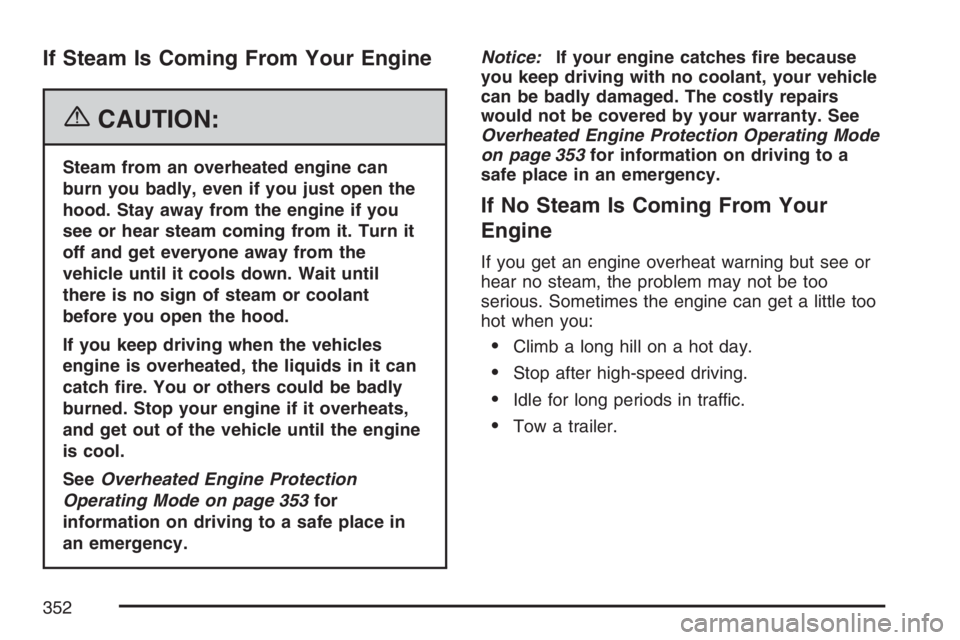
If Steam Is Coming From Your Engine
{CAUTION:
Steam from an overheated engine can
burn you badly, even if you just open the
hood. Stay away from the engine if you
see or hear steam coming from it. Turn it
off and get everyone away from the
vehicle until it cools down. Wait until
there is no sign of steam or coolant
before you open the hood.
If you keep driving when the vehicles
engine is overheated, the liquids in it can
catch �re. You or others could be badly
burned. Stop your engine if it overheats,
and get out of the vehicle until the engine
is cool.
SeeOverheated Engine Protection
Operating Mode on page 353for
information on driving to a safe place in
an emergency.Notice:If your engine catches �re because
you keep driving with no coolant, your vehicle
can be badly damaged. The costly repairs
would not be covered by your warranty. See
Overheated Engine Protection Operating Mode
on page 353for information on driving to a
safe place in an emergency.
If No Steam Is Coming From Your
Engine
If you get an engine overheat warning but see or
hear no steam, the problem may not be too
serious. Sometimes the engine can get a little too
hot when you:
Climb a long hill on a hot day.
Stop after high-speed driving.
Idle for long periods in traffic.
Tow a trailer.
352
Page 353 of 496
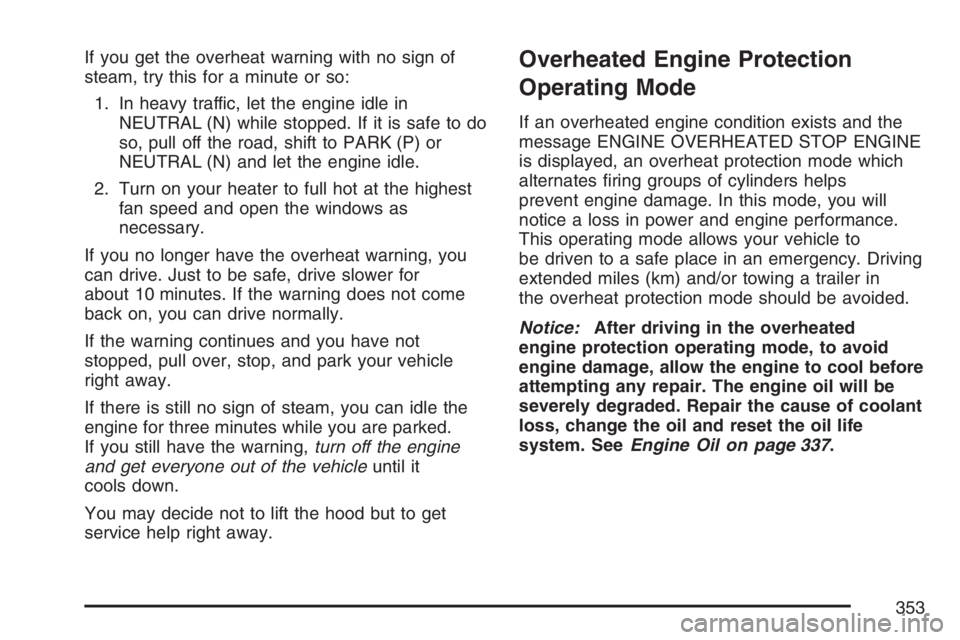
If you get the overheat warning with no sign of
steam, try this for a minute or so:
1. In heavy traffic, let the engine idle in
NEUTRAL (N) while stopped. If it is safe to do
so, pull off the road, shift to PARK (P) or
NEUTRAL (N) and let the engine idle.
2. Turn on your heater to full hot at the highest
fan speed and open the windows as
necessary.
If you no longer have the overheat warning, you
can drive. Just to be safe, drive slower for
about 10 minutes. If the warning does not come
back on, you can drive normally.
If the warning continues and you have not
stopped, pull over, stop, and park your vehicle
right away.
If there is still no sign of steam, you can idle the
engine for three minutes while you are parked.
If you still have the warning,turn off the engine
and get everyone out of the vehicleuntil it
cools down.
You may decide not to lift the hood but to get
service help right away.Overheated Engine Protection
Operating Mode
If an overheated engine condition exists and the
message ENGINE OVERHEATED STOP ENGINE
is displayed, an overheat protection mode which
alternates �ring groups of cylinders helps
prevent engine damage. In this mode, you will
notice a loss in power and engine performance.
This operating mode allows your vehicle to
be driven to a safe place in an emergency. Driving
extended miles (km) and/or towing a trailer in
the overheat protection mode should be avoided.
Notice:After driving in the overheated
engine protection operating mode, to avoid
engine damage, allow the engine to cool before
attempting any repair. The engine oil will be
severely degraded. Repair the cause of coolant
loss, change the oil and reset the oil life
system. SeeEngine Oil on page 337.
353